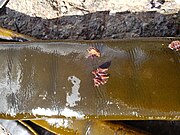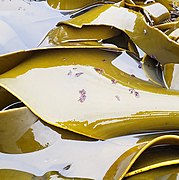
An epiphyte is a plant or plant-like organism that grows on the surface of another plant and derives its moisture and nutrients from the air, rain, water or from debris accumulating around it. The plants on which epiphytes grow are called phorophytes. Epiphytes take part in nutrient cycles and add to both the diversity and biomass of the ecosystem in which they occur, like any other organism. They are an important source of food for many species. Typically, the older parts of a plant will have more epiphytes growing on them. Epiphytes differ from parasites in that they grow on other plants for physical support and do not necessarily affect the host negatively. An organism that grows on another organism that is not a plant may be called an epibiont. Epiphytes are usually found in the temperate zone or in the tropics. Epiphyte species make good houseplants due to their minimal water and soil requirements. Epiphytes provide a rich and diverse habitat for other organisms including animals, fungi, bacteria, and myxomycetes.
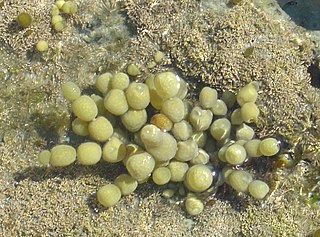
Hormosira banksii, also known as Neptune's necklace, Neptune's pearls, sea grapes, or bubbleweed) is a species of seaweed native to Australia and New Zealand. The genus Hormosira is monotypic.
Pyropia columbina, Southern laver, karengo in the Māori language and luche in the Spanish language, is a species of edible seaweed traditionally harvested by South Island Māori in New Zealand and Chilote people in Chile. It is closely related to Japanese Nori and Welsh laverbread.

Porphyra is a genus of coldwater seaweeds that grow in cold, shallow seawater. More specifically, it belongs to red algae phylum of laver species, comprising approximately 70 species. It grows in the intertidal zone, typically between the upper intertidal zone and the splash zone in cold waters of temperate oceans. In East Asia, it is used to produce the sea vegetable products nori and gim. There are considered to be 60–70 species of Porphyra worldwide and seven around Britain and Ireland, where it has been traditionally used to produce edible sea vegetables on the Irish Sea coast. The species Porphyra purpurea has one of the largest plastid genomes known, with 251 genes.
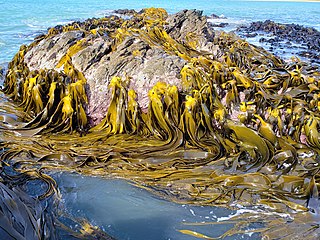
Durvillaea is a genus of large brown algae in the monotypic family Durvillaeaceae. All members of the genus are found in the southern hemisphere, including Australia, New Zealand, South America, and various subantarctic islands. Durvillaea, commonly known as southern bull kelps, occur on rocky, wave-exposed shorelines and provide a habitat for numerous intertidal organisms. Many species exhibit a honeycomb-like structure in their fronds that provides buoyancy, which allows individuals detached from substrates to raft alive at sea, permitting dispersal for hundreds of days over thousands of kilometres. Durvillaea species have been used for clothing, tools and as a food source by many indigenous cultures throughout the South Pacific, and they continue to play a prominent role in Chilean cuisine.

Durvillaea antarctica, also known as cochayuyo and rimurapa, is a large, robust species of southern bull kelp found on the coasts of Chile, southern New Zealand, and Macquarie Island. D. antarctica, an alga, does not have air bladders, but floats due to a unique honeycomb structure within the alga's blades, which also helps the kelp avoid being damaged by the strong waves.

Durvillaea willana is a large species of southern bull kelp endemic to New Zealand.

Red algae, or Rhodophyta, are one of the oldest groups of eukaryotic algae. The Rhodophyta comprises one of the largest phyla of algae, containing over 7,000 currently recognized species with taxonomic revisions ongoing. The majority of species (6,793) are found in the Florideophyceae (class), and mostly consist of multicellular, marine algae, including many notable seaweeds. Red algae are abundant in marine habitats but relatively rare in freshwaters. Approximately 5% of red algae species occur in freshwater environments, with greater concentrations found in warmer areas. Except for two coastal cave dwelling species in the asexual class Cyanidiophyceae, there are no terrestrial species, which may be due to an evolutionary bottleneck in which the last common ancestor lost about 25% of its core genes and much of its evolutionary plasticity.
Bangia is an extant genus of division Rhodophyta that grows in marine or freshwater habitats. Bangia has small thalli with rapid growth and high reproductive output, and exhibits behavior characteristic of r-selected species. The plants are attached by down-growing rhizoids, usually in dense purple-black to rust-colored clumps. The chloroplasts of Bangia, like others in the division Rhodophyta, contain chlorophyll a and sometimes chlorophyll d, as well as accessory pigments such as phycobilin pigments and xanthophylls. Depending on the relative proportions of these pigments and the light conditions, the overall color of the plant can range from green to red to purple to grey; however, the red pigment, phycoerythrin, is usually dominant.
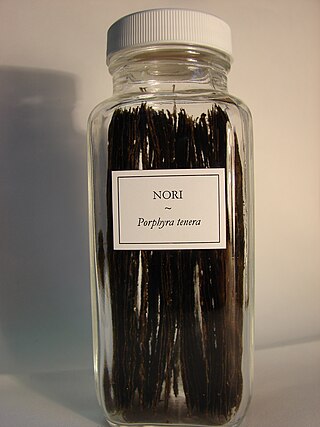
Pyropia tenera, also known as gim or nori, is a red algal species in the genus Pyropia. The specific name, tenera, means "delicate" and alludes to its small size. It typically grows to lengths between 20 and 50 cm. It is most typically found in the western Pacific Ocean and the Indian Ocean.
Porphyra cinnamomea is a red alga species in the genus Porphyra, known from New Zealand. It is monostromatic, monoecious, and grows in the intertidal zone, predominantly on rock substrata. With P. coleana, P. rakiura and P. virididentata, they can be distinguished by morphology, as well as geographical, ecological and seasonal distribution patterns, and importantly, chromosome numbers, which in this species n = 3. Finally, these four species are distinguished by a particular nucleotide sequence at the 18S rDNA locus.

Clymene coleana, formerly known as Porphyra cinnamomea, is a red alga species in the family Bangiaceae. It is the only species in the monotypic genus Clymene. This species is endemic to New Zealand.
Pyropia rakiura, formerly known as Porphyra rakiura, is a red alga species in the genus Pyropia, known from New Zealand. It is monostromatic, monoecious, and grows in the intertidal zone, predominantly on rock substrata. With P. cinnamomea, P. coleana and P. virididentata, they can be distinguished by morphology, as well as geographical, ecological and seasonal distribution patterns, and importantly, chromosome numbers, which in this species n = 2. Finally, these four species are distinguished by a particular nucleotide sequence at the 18S rDNA locus.
Pyropia virididentata, formerly known as Porphyra virididentata, is a red alga species in the genus Pyropia. It is endemic to New Zealand. It is monostromatic, monoecious, and grows in the intertidal zone, predominantly on rock substrata. With Porphyra cinnamomea, Pyropia rakiura and Clymene coleana, they can be distinguished by morphology, as well as geographical, ecological and seasonal distribution patterns, and importantly, chromosome numbers, which in this species n = 3. Finally, these four species are distinguished by a particular nucleotide sequence at the 18S rDNA locus.

Pyropia is a genus of red algae in the family Bangiaceae. It is found around the world in intertidal zones and shallow water. The genus has folding frond-like blades which are either red, brown or green. Some Pyropia species are used to create nori, and are thus important subjects for aquaculture.
Pythium porphyrae, is a parasitic species of oomycete in the family Pythiaceae. It is the cause of red rot disease or red wasting disease, also called akagusare (赤ぐされ) in Japanese. The specific epithet porphyrae (πορφυρα) stems from the genus of one of its common hosts, Porphyra, and the purple-red color of the lesions on the thallus of the host. However, many of its hosts have been moved from the genus Porphyra to Pyropia.

Bangiaceae is a family of red algae in the order Bangiales. It contains laver, used to make laverbread, and various species in the genus of Pyropia are used to make nori.

Durvillaea poha is a large, robust species of southern bull kelp found in New Zealand.

Peyssonneliales is a monotypic order of red algae belonging to the class Florideophyceae and the subclass Rhodymeniophycidae. It contains only 1 known family, PeyssonneliaceaeDenizot, M., 1968.
Kathleen "Kay" Margaret Cole was a Canadian phycologist, known as one of the world's leading experts in the cytology of marine algae. In 1998 the Canadian Botanical Society awarded her the George Lawson Medal for lifetime achievement.


